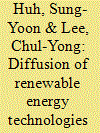|
|
|
Sort Order |
|
|
|
Items / Page
|
|
|
|
|
|
|
| Srl | Item |
| 1 |
ID:
132658


|
|
|
|
|
| Publication |
2014.
|
| Summary/Abstract |
Renewable energy technologies (RETs) have attracted significant public attention for several reasons, the most important being that they are clean alternative energy sources that help reduce greenhouse gas emissions. To increase the probability that RETs will be successful, it is essential to reduce the uncertainty about its adoption with accurate long-term demand forecasting. This study develops a diffusion model that incorporates the effect of competitive interrelationships among renewable sources to forecast the growth pattern of five RETs: solar photovoltaic, wind power, and fuel cell in the electric power sector, and solar thermal and geothermal energy in the heating sector. The 2-step forecasting procedure is based on the Bayus, (1993. Manage. Sci. 39, 11, 1319-1333) price function and a diffusion model suggested by Hahn et al. (1994. Marketing Sci. 13, 3, 224-247). In an empirical analysis, the model is applied to the South Korean renewable energy market.
|
|
|
|
|
|
|
|
|
|
|
|
|
|
|
|
| 2 |
ID:
150675


|
|
|
|
|
| Summary/Abstract |
The importance of renewable energy as a response to climate change is universally acknowledged. However, its successful implementation requires public approval and cooperation. This study aims to identify the level of renewable energy acceptance in Korea by estimating Korean consumers’ additional willingness to pay (WTP) using the contingent valuation (CV) method, which is the most widely used to analyze consumer preferences. The estimation results indicate that Korean consumers are willing to pay an additional USD 3.21 per month for electricity generated with renewable energy. However, WTP in Korea is low relative to other advanced nations, indicating that these values could be influenced through policies aimed at improving knowledge and acceptance of renewable energy sources among Korean consumers.
|
|
|
|
|
|
|
|
|
|
|
|
|
|
|
|
| 3 |
ID:
149908


|
|
|
|
|
| Summary/Abstract |
Among the various alternatives available to reduce greenhouse gas (GHG) emissions, carbon capture and storage (CCS) is considered to be a prospective technology that could both improve economic growth and meet GHG emission reduction targets. Despite the importance of CCS, however, studies of technology and demand forecasting for CCS are scarce. This study bridges this gap in the body of knowledge on this topic by forecasting CCS technology and demand based on an integrated model. For technology forecasting, a logistic model and patent network analysis are used to compare the competitiveness of CCS technology for selected countries. For demand forecasting, a competition diffusion model is adopted to consider competition among renewable energies and forecast demand. The results show that the number of patent applications for CCS technology will increase to 16,156 worldwide and to 4,790 in Korea by 2025. We also find that the United States has the most competitive CCS technology followed by Korea and France. Moreover, about 5 million tCO2e of GHG will be reduced by 2040 if CCS technology is adopted in Korea after 2020.
|
|
|
|
|
|
|
|
|
|
|
|
|
|
|
|
|
|
|
|
|